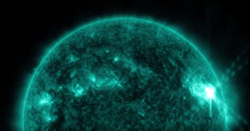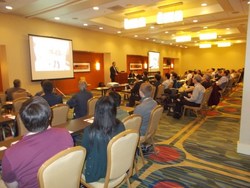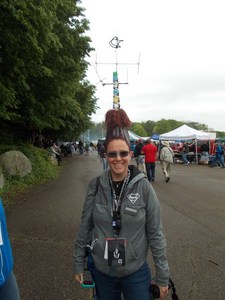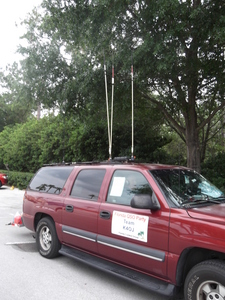 June 1, 2016 Editor: Paul Bourque, N1SFE | |||||
IN THIS ISSUE
Sometimes contests have quirky rules, exchanges, and some even have prizes. This weekend, you could earn a T-shirt with a category win in the DigiFest contest. Or, for extra scoring suspense, in the Dutch Kingdom Contest, Dutch expats count as additional hidden multipliers -- you won't be able to tell they're multipliers until your log is scored. DKARS explains the contest more fully in their online monthly magazine. Domestically, the Potomac Valley Radio Club's Reunion event on June 5 invites all amateurs to participate, but current and past PVRC members send a special exchange. The 12 hour Alabama QSO Party is also an option. The weekend of June 11, get on 50 MHz or above for the ARRL June VHF contest. Don't forget the new rules allowing self-spotting. CW and SSB will be the modes for most sporadic E contacts should they occur, but don't forget to check for FM activity. The 2016 ARRL Field Day is only four weekends away! The Contest Update would like your input! What would you like to see more of in the Contest Update? How can we improve? How can we serve you better? Please take a moment to fill out a brief reader survey. Your comments are also always welcome at any time via e-mail to contest-update@arrl.org. Thanks! BUSTED QSOS None last time. Complete information for all contests follows the Conversation section June 2 June 3 June 4
June 5 June 6 June 7 June 8 June 9 June 10 June 11
June 12 June 15 The Board of Directors of the Yasme Foundation is pleased to announce a number of supporting grants in furtherance of its goal of supporting the development of Amateur Radio. These grants are in support of encouraging youth participation in Amateur Radio and operating activities. The Yasme Foundation encourages amateurs to support activities that promote Amateur Radio and result in new licensees around the world. Scholarships and Youth Programs
HF Operating Around the World
You can read about the Estonian contest operation on the Region 1 YOTA website. In even more Yasme news, the Board of Directors of The Yasme Foundation is pleased to announce the award of the Yasme Excellence Award to the following individuals:
In West Virginia, there's a nice radio-quiet location for sale, but it's suitable only for receive antennas, as it's in the US National Radio Quiet Zone. As you likely know, incandescent light bulbs are being phased out due to more efficient alternatives provided by fluorescent and LED technologies. However, some efficiency strides have been made recently with incandescent light bulbs, and perhaps we'll see their return in a few years. The "scaling up" of things we're familiar with is often interesting because of the challenges inherent in just making things bigger. Whether it's OH8X's beam for 160 meters (RIP), W7RN's stacking of 80 meter beams, or refurbishing a machine that weighs 1 million pounds, things are different at larger scales. For the long-term benefit of your multiop team members, feed them well during contest weekend. Yes, there will be an August UHF contest! Wayne Overbeck, N6NB, has set up UHFContest.org as the new home for information on the August event. The log submission process, arranged by John Kalenowsky, K9JK, is nearly identical, but for a new log submission e-mail address. Additionally, there is a small rule change to accommodate mobiles in same-grid rover activity. Please see the August UHF contest website for more information. Many have heard of the Enigma machine, a encryption/decryption device used by Germany and others in World War II, and the subject of intense decryption efforts by the Allied Forces; a lesser-known and more rare German cipher device called a Lorenz machine was recently re-discovered after it was the subject of an eBay auction. This rare machine was literally a "barn find." Tim, K3HX, recommends the book The Sun Kings by Stuart Clark, which is "mostly about the 'Carrington Event' of 1859 when the Earth got blasted by a huge CME. From a ham radio standpoint, there's quite a bit about the nature of sunspots and how they were determined to work." Stub - a sized piece of transmission line with only one end attached to a feed line. The other end is usually left open, or shorted. By using a stub's ability to transform impedance, it is possible to construct filters that present a high or low impedance to signals at particular design frequencies. Stubs of transmission line can be attached using "T" connectors. Typically, a shorted stub for a particular frequency is used to eliminate even-numbered harmonics of that frequency. Stubs are can be used at the output of transmitters or amplifiers, where conventional tuned networks may be less practical due to transmit power levels. For more information on stubs, see K9YC's document on Coax and Stubs, the ARRL Antenna Book, and the excellent Managing Interstation Interference by George, W2VJN.
On April 17, an M6.7 flare caused moderate radio blackouts. NASA observed the event and recorded it at various ultra-violet wavelengths. The high resolution video translated those normally-invisible wavelengths into colors we can see. (David, KK6DA) The ARRL had a notable presence at the recent 2016 International Microwave Symposium in San Francisco, with the first-ever panel session on Amateur Radio in education entitled "Using Amateur Radio to Enhance Engineering Education."
Four institutions with programs were highlighted, along with their representatives: California Polytechnic State University (Dr Dennis Derickson, AC0P); Carnegie Mellon University, Silicon Valley (Bob Iannucci, W6EI); University of California, Davis (Dr Xiaoguang Liu, AI6DW); and University of Nepal at Kathmandu (Dr Sanjeeb Panday, 9N1SP). These institutions use Amateur Radio in their engineering curricula as a means for students to gain practical, system-level experience with wireless communications systems. What goes in Dayton...sometimes shows up on YouTube! The 2016 Spurious Emissions Band's performance as part of the Contest Super
Suite has been posted. Bob, N6TV, notes that the lyrics for each song can be viewed in the description. The Results of the 2016 7QP Contest, which occurred May 7-8, 2016, have been posted. Despite challenging conditions caused by a solar flare during the contest affecting high bands, and weather-induced noisy low band conditions, over ninety thousand QSOs were made with over six thousand distinct callsigns. Over six hundred logs were submitted. Of the eight Outside-7th-Call-Area plaques, California operators captured six! Of particular note was WW7D, who as a SOLP mobile operator covered 28 counties in Oregon, Idaho, and Wyoming, solo. The dates for the 2017 7QP will be May 6 and 7.
Jim White, K4OJ, a respected and beloved contester, died in 2004. The Florida Contest Group keeps his memory and spirit alive by contesting with his call. After the recent 2016 Florida QSO Party, K4OJ MM/m team member Chris, NX4N, reported "47 Counties, 3505 QSOs, 77 Mults, 1.08M points -- FLQP 2016 is now in the books and it was another Super Fun Ride for team K4OJ MM/m!" The team, consisting of Chris, NX4N, Red, K0LUZ, and Kevin, N4KM, ran two stations simultaneously while mobile. Chris's write-up on the CQ-Contest reflector provides the details, including some troubleshooting tips they needed to stay on the air. Here's an article from NCJ on K4OJ MM/m's 2015 effort in the same contest. From Ed, W0YK: "Slow down to win." If you are running stations on a frequency, pause briefly after you have copied a response to your CQ, to potentially pick up another call sign or two. In this way, it's possible to chain contacts to avoid calling CQ, and have a faster rate. For example, the normal exchange of: Me: CQ N9ADG TEST Caller1: N7QT (I hear other stations calling but don't pause to copy any of the calls) Me: N7QT 599 WA Caller1: 599 VT Me: TU N9ADG TEST Caller2: K7EDX Me: K7EDX 599 WA Caller2: 599 WA Me: TU N9ADG TEST Can become: Me: CQ N9ADG TEST Caller1: N7QT <I take a short pause even though I've copied N7QT> Caller2: K7EDX <I copied K7EDX's call, too> Me: N7QT 599 WA Caller1: 599 VT Me: TU NW K7EDX 599 WA Caller2: 599 WA Me: TU N9ADG TEST This can be especially easy if your logging program supports call sign stacking. You may find that stations will recognize your "mad stacking skillz" and may attempt to insert their call after the other station sends their exchange. This can help you, but if not done correctly, or if not managed well, it can slow things down. For more information, see Ed's Operating a RTTY Contest PDF presentation from 2013, slides 40-43. Super Bonus Field Day Tip This one is from Ward, N0AX, revealed during a Question and Answer session at Contest University: Use a sheet of heavy-duty aluminum foil as a desk ground surface during Field Day. Tape the sheet down to the operating table near the back edge, then place rigs and other equipment on top of the foil. Make sure that the foil and the grounds of all of the equipment are tied to a robust ground bus. Make sure it's truly ground. There's new online content to go with the ARRL Antenna Book. Ward, N0AX, writes: "I've added a couple of cool things to the Antenna Book web page at www.arrl.org/arrl-antenna-book-reference. Since we can't update the Antenna Book every year like we do the Handbook, I'm going to start adding the occasional article to the website from time to time. You can find this content under the 'Supplemental Information and Files' menu on the Antenna Book web page. Antenna Designs - Additional articles providing interesting and special-purpose antenna designs. The list will expand with more articles over time. Check back from time to time for new additions! "An Ultra-Light Yagi for Transatlantic and Other Extreme DX" by VE1FA from the Mar/Apr 2016 issue of TCA (The Canadian Amateur Magazine). This rope-suspended antenna was designed by VE1FA for his team's pursuit of the Brendan Quest award for the first two-way transatlantic QSO on 2 meters using only natural propagation. So far, they've been heard "across the pond," but haven't completed the necessary QSO. Here is the EZNEC model (in compressed .zip format) for the antenna as well as a text file with measurements of the antenna. Article Lists -- The downloadable Excel spreadsheet "Antenna Article Master Directory" contains the Tables of Contents for the entire ARRL Antenna Compendium series, Volumes 1-8, Wire Antenna Classics and More Wire Antenna Classics, Yagi Antenna Classics, Portable Antenna Classics, and Simple and Fun Antennas. The articles may be sorted according to a number of topics that apply to the articles, making it easier for you to find articles for your particular situation or application. (Updated 1 April 2016) There's not an SSB Skimmer, yet, but here's an example of someone using cloud-based speech recognition APIs (Application Programming Interfaces) for a non-trivial application: "Say-what," an agent that pays attention to an online meeting for you. Here's how it works, according to the author, Josh Newlan: "I wrote a script that listens to meetings I'm supposed to be paying attention to and pings me ... when my name is mentioned. It sends me a transcript of what was said in the 30 seconds before my name was mentioned and everything within 30 seconds after." The program pipes audio to IBM's Watson Speech to Text API in real-time. Josh has even made the source code available. It would be an interesting test to see what Watson could do with listening to a run frequency. Imagine expanding the ICs in our rigs into discrete components, using transistors, resistors, and so on. Well, someone has done that with a popular microprocessor of yesteryear, the 6502. Dubbed the MOnSter 6502, with added LEDs it is quite the conversation starter. It was on display at the Bay Area Maker Faire, which ran concurrently with the Dayton Hamvention. UK Researchers have determined that bumblebees can sense electric fields using the hairs on their body. It remains unclear whether they actually use this ability to better find food, or navigate. Will televisions of the future be susceptible to RFI? They may not have tuners, and may more resemble computers with large screens. Wi-Fi at 2.4 GHz is saturated in many areas, and it's predicted that the 5 GHz band will be as crowded in 2 to 3 years. The next frontier of Wi-Fi operates at 60 GHz, with support beginning to show up from some smartphone vendors. There's also new name: WiGig. As one of the fundamental building blocks for SDRs in their many implementations, the Fourier Transform's history began in the 18th century. It became practical to process signals in real-time only after Cooley and Tukey's 1965 re-discovery of the "fast" algorithm first described by Gauss in 1805. Just in time for that summer radio project! Here's a survey of free PCB design software by EE Times. Dayton Diversified It's hard to come back to "normal life" after being immersed in the Dayton experience for 4 days. My impression of this year's weekend was that it continues to be vibrant in 2016. Thursday's Contest University was sold out. CTU attendees had the opportunity to interact with the experts and make new connections, and were provided with hundreds of pages of materials that they can continue to reference. On Friday, Hamvention opened to packed crowds. Many of the new products introduced during Hamvention and initially available at Hara Arena were in short supply or sold out by Saturday. The various forums seemed uniformly crowded, and the crowds actively engaged. As the arena closed in the evenings, contest- and DX-oriented activities, including dinners and hospitality suites, went into the wee hours at various other locations. I regret that I ran out of time to visit any portion of the Four Days in May (FDIM) event, which was going on about 17 miles from the Hara Arena. I asked Guy, N7UN, about FDIM, and his presentation focused around portable operation and NPOTA/SOTA: My FDIM presentation by N7UN on "2016 -- The Year of the /p Operator" was well received by the 300+ crowd at the Fairborn Holiday Inn. There was acknowledgment of a convergence of lightweight batteries, lightweight but effective antennas (e.g. EFHW) coupled with fiberglass fishing masts, and of course lightweight backpacks to carry it all for Activators. And the Chasers are "tenacious" in seeking those Activators that are on the air! Just like chasing DX! NPOTA (National Parks on the Air) is an ARRL awards program. It is attracting a huge following of both Activators and Chasers and is surely set to break the ARRL Centennial 2014 program record in terms of participation and total QSOs. SOTA (Summits on the Air) has been going since 2002 but is really gaining popularity in North America in the past few years, especially with over 51,000 SOTA-qualified peaks on this continent. So there will be life after NPOTA! It is easy to get started with these programs:
Both programs have enthusiastic communities of portable operators and chasers which makes it great fun to share all the stories! NPOTA has a Facebook page while SOTA for North America has a Yahoo Group. Thanks Guy! Don't forget about the NPOTA statistics page. At the time this was written, nearly 400,000 NPOTA QSOs have been uploaded to LoTW. If you're looking for a rare NPOTA unit to activate, click on the "Activations" column to sort by units in the order of most-to-least or least-to-most activated. That's all for this time. Don't forget to complete the Contest Update survey. And as always, send contesting related stories, book reviews, tips, techniques, press releases, errata, schematics, club information, pictures, stories, blog links, predictions, and Field Day recipes to contest-update@arrl.org 73, Brian N9ADG 1 Jun - 13 Jun 2016 An expanded, downloadable version of QST's Contest Corral in PDF format is available. Check the sponsor's website for information on operating time restrictions and other instructions. HF CONTESTS CWops Mini-CWT Test, Jun 1, 1300z to Jun 1, 1400z, Jun 1, 1900z to Jun 1, 2000z, Jun 2, 0300z to Jun 2, 0400z; CW; Bands: 160, 80, 40, 20, 15, 10m; Member: Name + Member No., non-Member: Name + (state/province/country); Logs due: June 4. SJRA 100 Year Anniversary QSO Party, Jun 10, 0000z to Jun 19, 2359z. See rules for additional information. VHF+ CONTESTS UKSMG Summer Contest, Jun 4, 1300z to Jun 5, 1300z; not specified; Bands: 6m Only; RST + Serial No. + 6-character grid square + (optional UKSMG member no.); Logs due: July 1. REF DDFM 6m Contest, Jun 11, 1600z to Jun 12, 1600z; CW, SSB, FM; Bands: 6m Only; RS(T) + Serial No. + 4-character grid square; Logs due: July 12. Also see Dutch Kingdom Contest, and SKCC Weekend Sprintathon, above. June 3, 2016 June 4, 2016 June 5, 2016 June 6, 2016 June 7, 2016 June 10, 2016 June 11, 2016 June 13, 2016 June 15, 2016 ARRL Information Click here to advertise in this newsletter, space subject to availability. Your One-Stop Resource for Amateur Radio News and Information ARRL membership includes QST, Amateur Radio's most popular and informative journal, delivered to your mailbox each month. Subscribe to NCJ - the National Contest Journal. Published bimonthly, features articles by top contesters, letters, hints, statistics, scores, NA Sprint and QSO Parties. Subscribe to QEX - A Forum for Communications Experimenters. Published bimonthly, features technical articles, construction projects, columns and other items of interest to radio amateurs and communications professionals. Free of charge to ARRL members: Subscribe to The ARRL Letter (weekly digest of news and information), the ARES E-Letter (monthly public service and emergency communications news), Division and Section news -- and much more! ARRL offers a wide array of products to enhance your enjoyment of Amateur Radio. Visit the site often for new publications, specials and sales. Donate to the fund of your choice -- support programs not funded by member dues! Reprint permission can be obtained by sending email to permission@arrl.org with a description of the material and the reprint publication. ACKNOWLEDGEMENTS ARRL Contest Update wishes to acknowledge information from WA7BNM's Contest Calendar and SM3CER's Contest Calendar. | |||||










